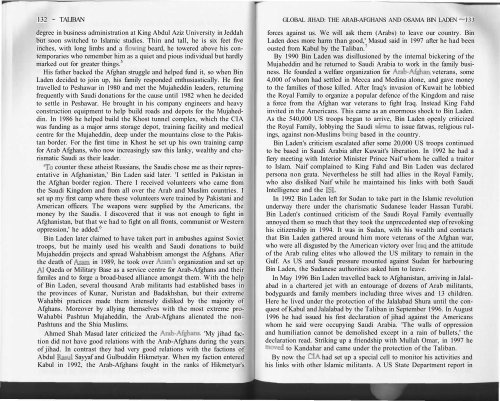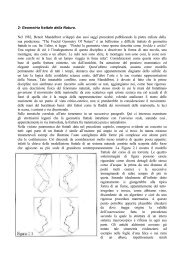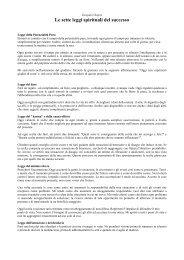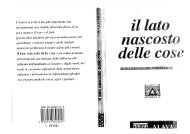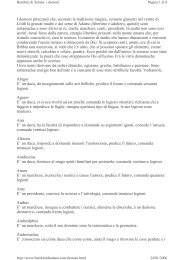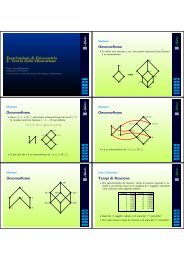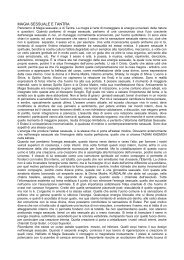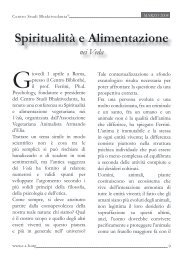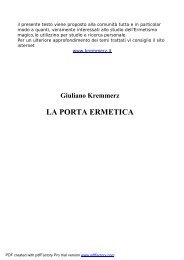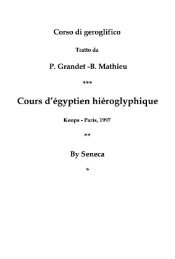132 ~ TALIBANdegree in business administration at King Abdul Aziz <strong>University</strong> in Jeddahbut soon switched to Islamic studies. Thin and tall, he is six feet fiveinches, with long limbs and a flowing beard, he towered above his contemporarieswho remember him as a quiet and pious individual but hardlymarked out for greater things. 5His father backed the Afghan struggle and helped fund it, so when BinLaden decided to join up, his family responded enthusiastically. He firsttravelled to Peshawar in 1980 and met the Mujaheddin leaders, returningfrequently with Saudi donations for the cause until 1982 when he decidedto settle in Peshawar. He brought in his company engineers and heavyconstruction equipment to help build roads and depots for the Mujaheddin.In 1986 he helped build the Khost tunnel complex, which the CIAwas funding as a major arms storage depot, training facility and medicalcentre for the Mujaheddin, deep under the mountains close to the Pakistanborder. For the first time in Khost he set up his own training campfor Arab Afghans, who now increasingly saw this lanky, wealthy and charismaticSaudi as their leader.'To counter these atheist Russians, the Saudis chose me as their representativein Afghanistan,' Bin Laden said later. 'I settled in Pakistan inthe Afghan border region. There I received volunteers who came fromthe Saudi Kingdom and from all over the Arab and Muslim countries. Iset up my first camp where these volunteers were trained by Pakistani andAmerican officers. The weapons were supplied by the Americans, themoney by the Saudis. I discovered that it was not enough to fight inAfghanistan, but that we had to fight on all fronts, communist or Westernoppression,' he added. 6Bin Laden later claimed to have taken part in ambushes against Soviettroops, but he mainly used his wealth and Saudi donations to buildMujaheddin projects and spread Wahabbism amongst the Afghans. Afterthe death of Azam in 1989, he took over Azam's organization and set upAl Qaeda or Military Base as a service centre for Arab-Afghans and theirfamiles and to forge a broad-based alliance amongst them. With the helpof Bin Laden, several thousand Arab militants had established bases inthe provinces of Kunar, Nuristan and Badakhshan, but their extremeWahabbi practices made them intensely disliked by the majority ofAfghans. Moreover by allying themselves with the most extreme pro-Wahabbi Pashtun Mujaheddin, the Arab-Afghans alienated the non-Pashtuns and the Shia Muslims.Ahmed Shah Masud later criticized the Arab-Afghans. 'My jihad factiondid not have good relations with the Arab-Afghans during the yearsof jihad. In contrast they had very good relations with the factions ofAbdul Rasul Sayyaf and Gulbuddin Hikmetyar. When my faction enteredKabul in 1992, the Arab-Afghans fought in the ranks of Hikmetyar'sGLOBAL JIHAD: THE ARAB-AFGHANS AND OSAMA BIN LADEN ~ 133forces against us. We will ask them (Arabs) to leave our country. BinLaden does more harm than good,' Masud said in 1997 after he had beenousted from Kabul by the Taliban. 7By 1990 Bin Laden was disillusioned by the internal bickering of theMujaheddin and he returned to Saudi Arabia to work in the family business.He founded a welfare organization for Arab-Afghan veterans, some4,000 of whom had settled in Mecca and Medina alone, and gave moneyto the families of those killed. After Iraq's invasion of Kuwait he lobbiedthe Royal Family to organize a popular defence of the Kingdom and raisea force from the Afghan war veterans to fight Iraq. Instead King Fahdinvited in the Americans. This came as an enormous shock to Bin Laden.As the 540,000 US troops began to arrive, Bin Laden openly criticizedthe Royal Family, lobbying the Saudi ulema to issue fatwas, religious rulings,against non-Muslims being based in the country.Bin Laden's criticism escalated after some 20,000 US troops continuedto be based in Saudi Arabia after Kuwait's liberation. In 1992 he had afiery meeting with Interior Minister Prince Naif whom he called a traitorto Islam. Naif complained to King Fahd and Bin Laden was declaredpersona non grata. Nevertheless he still had allies in the Royal Family,who also disliked Naif while he maintained his links with both SaudiIntelligence and the ISI.In 1992 Bin Laden left for Sudan to take part in the Islamic revolutionunderway there under the charismatic Sudanese leader Hassan Turabi.Bin Laden's continued criticism of the Saudi Royal Family eventuallyannoyed them so much that they took the unprecedented step of revokinghis citizenship in 1994. It was in Sudan, with his wealth and contactsthat Bin Laden gathered around him more veterans of the Afghan war,who were all disgusted by the American victory over Iraq and the attitudeof the Arab ruling elites who allowed the US military to remain in theGulf. As US and Saudi pressure mounted against Sudan for harbouringBin Laden, the Sudanese authorities asked him to leave.In May 1996 Bin Laden travelled back to Afghanistan, arriving in Jalalabadin a chartered jet with an entourage of dozens of Arab militants,bodyguards and family members including three wives and 13 children.Here he lived under the protection of the Jalalabad Shura until the conquestof Kabul and Jalalabad by the Taliban in September 1996. In August1996 he had issued his first declaration of jihad against the Americanswhom he said were occupying Saudi Arabia. 'The walls of oppressionand humiliation cannot be demolished except in a rain of bullets,' thedeclaration read. Striking up a friendship with Mullah Omar, in 1997 hemoved to Kandahar and came under the protection of the Taliban.By now the CIA had set up a special cell to monitor his activities andhis links with other Islamic militants. A US State Department report in
134TALIBANAugust 1996 noted that Bin Laden was 'one of the most significant financialsponsors of Islamic extremist activities in the world'. The report saidthat Bin Laden was financing terrorist camps in Somalia, Egypt, Sudan,Yemen, Egypt and Afghanistan. In April 1996, President Clinton signedthe Anti-Terrorism Act which allowed the US to block assets of terroristorganizations. It was first used to block Bin Laden's access to his fortuneof an estimated US$250-300 million. 8 A few months later Egyptian intelligencedeclared that Bin Laden was training 1,000 militants, a secondgeneration of Arab-Afghans, to bring about an Islamic revolution in Arabcountries. 9In early 1997 the CIA constituted a squad which arrived in Peshawarto try and carry out a snatch operation to get Bin Laden out of Afghanistan.The Americans enlisted Afghans and Pakistanis to help them butaborted the operation. The US activity in Peshawar helped persuade BinLaden to move to the safer confines of Kandahar. On 23 February 1998,at a meeting in the original Khost camp, all the groups associated withAl Qaeda issued a manifesto under the aegis of 'The International IslamicFront for jihad against Jews and Crusaders'. The manifesto stated 'for morethan seven years the US has been occupying the lands of Islam in theholiest of places, the Arabian peninsular, plundering its riches, dictatingto its rulers, humiliating its people, terrorizing its neighbours, and turningits bases in the peninsular into a spearhead through which to fight theneighbouring Muslim peoples'.The meeting issued a fatwa. 'The ruling to kill the Americans and theirallies — civilians and military - is an individual duty for every Muslimwho can do it in any country in which it is possible to.' Bin Laden hadnow formulated a policy that was not just aimed at the Saudi Royal Familyor the Americans but called for the liberation of the entire Muslim MiddleEast. As the American air war against Iraq escalated in 1998, Bin Ladencalled on all Muslims to 'confront, fight and kill' Americans and Britons. 10However, it was the bombings in August 1998 of the US Embassies inKenya and Tanzania that killed 220 people which made Bin Laden ahousehold name in the Muslim world and the West. Just 13 days later,after accusing Bin Laden of perpetrating the attack, the USA retaliatedby firing 70 cruise missiles against Bin Laden's camps around Khost andJalalabad. Several camps which had been handed over by the Taliban tothe Arab-Afghans and Pakistani radical groups were hit. The Al Badrcamp controlled by Bin Laden and the Khalid bin Walid and Muawiacamps run by the Pakistani Harakat ul Ansar were the main targets.Harakat used their camps to train militants for fighting Indian troops inKashmir. Seven outsiders were killed in the strike - three Yemenis, twoEgyptians, one Saudi and one Turk. Also killed were seven Pakistanis and20 Afghans.GLOBAL JIHAD: THE ARAB-AFGHANS AND OSAMA BIN LADEN ~ 135In November 1998 the USA offered a US$5-million reward for BinLaden's capture. The Americans were further galvanized when Bin Ladenclaimed that it was his Islamic duty to acquire chemical and nuclearweapons to use against the USA. 'It would be a sin for Muslims not totry to possess the weapons that would prevent infidels from inflicting harmon Muslims. Hostility towards America is a religious duty and we hope tobe rewarded for it by God,' he said. 11Within a few weeks of the Africa bombings, the Clinton administrationhad demonized Bin Laden to the point of blaming him for every atrocitycommitted against the USA in the Muslim world in recent times. In thesubsequent indictment against him by a New York court, Bin Laden wasblamed for the 18 American soldiers killed in Mogadishu, Somalia in1993; the deaths of five servicemen in a bomb attack in Riyadh in 1995and the deaths of another 19 US soldiers in Dhahran in 1996. He wasalso suspected of having a hand in bombings in Aden in 1992, the WorldTrade Centre bombing in 1993, a 1994 plot to kill President Clinton inthe Phillipines and a plan to blow up a dozen US civilian aircraft in1995. 12 There was a great deal of scepticism, even amongst US expertsthat he was involved in many of these latter operations. 13But the Clinton administration was desperately looking for a diversionas it wallowed through the mire of the Monica Lewinsky affair and alsoneeded an all-purpose, simple explanation for unexplained terrorist acts.Bin Laden became the centre of what was promulgated by Washingtonas a global conspiracy against the USA. What Washington was not preparedto admit was that the Afghan jihad, with the support of the CIA,had spawned dozens of fundamentalist movements across the Muslimworld which were led by militants who had grievances, not so muchagainst the Americans, but their own corrupt, incompetent regimes. Asearly as 1992-93 Egyptian and Algerian leaders at the highest level hadadvised Washington to re-engage diplomatically in Afghanistan in orderto bring about peace so as to end the presence of the Arab-Afghans.Washington ignored the warnings and continued to ignore Afghanistaneven as the civil war there escalated. 14The Algerians were justified in their fears, for the first major eruptionfrom the ranks of the Arab-Afghans came in Algeria. In 1991 the IslamicSalvation Front (FIS) won the first round of parliamentary electionstaking some 60 per cent of the seats countrywide. The Algerian armycancelled the results, declared Presidential rule in January 1992 andwithin two months a vicious civil war began which had claimed some70,000 lives by 1999. FIS itself was outmanoeuvered by the more extremeIslamic Jihad, which in 1995 changed its name to the Armed IslamicGroup (GIA). GIA was led by Algerian Afghans - Algerian veteransfrom the Afghan war - who were neo-Wahabbis and set an agenda that
- Page 1 and 2:
YALE NOTA BENE"The broader storyher
- Page 3 and 4:
TalibanMilitant Islam,Oil and Funda
- Page 5 and 6:
Vi ~ CONTENTSChapter 8A Vanished Ge
- Page 7 and 8:
AFGHANISTAN•^ UZBEKISTAN J TAJIKI
- Page 9 and 10:
2 ~ TALIBANaccounts for some 40 per
- Page 11 and 12:
"6 ~ TALIBANgas riches of landlocke
- Page 13 and 14:
10 ~ TALIBANgious mix that was to m
- Page 15 and 16:
Part 1History of theTaliban Movemen
- Page 17 and 18:
18 ~ ISLAM OIL AND THE NEW GREAT GA
- Page 19 and 20:
22 ~ ISLAM OIL AND THE NEW GREAT GA
- Page 21 and 22:
26 ~ ISLAM OIL AND THE NEW GREAT GA
- Page 23 and 24: 30 ~ ISLAM OIL AND THE NEW GREAT GA
- Page 25 and 26: 34 TALIBANKabul- Hikmetyar had alli
- Page 27 and 28: 38 ~ TALIBANrHERAT 1995: GOD'S INVI
- Page 29 and 30: 42 ~ TALIBANdo manage to take Kabul
- Page 31 and 32: J46 ~ TALIBANgreater weight to UN e
- Page 33 and 34: 50 ~ TALIBANas they hung from steel
- Page 35 and 36: 54 ~ TALIBANthey would help rearm t
- Page 37 and 38: 58 TALIBANGul Mohammed Pahlawan, Gh
- Page 39 and 40: 62 TALIBAN2,500 Taliban, who had re
- Page 41 and 42: 66 TALIBANshould throw all aid agen
- Page 43 and 44: 70 ~ TALIBANyears of battle and hel
- Page 45 and 46: 74 ~ TALIBANThousands of Hazaras we
- Page 47 and 48: 78 TALIBANhas become a plague,' sai
- Page 49 and 50: NEW STYLE FUNDAMENTALISM OF THE TAL
- Page 51 and 52: 86 TALIBANsity students - Hikmetyar
- Page 53 and 54: 90 TALIBANSharia was heavily influe
- Page 55 and 56: 94 TALIBANinflamed the debate in th
- Page 57 and 58: 98 TALIBANizing factor of Islam, it
- Page 59 and 60: 102 TALIBANadministrations made the
- Page 61 and 62: 106 ~ TAUBANfrom working, but it no
- Page 63 and 64: TALIBANUniversity, she held down a
- Page 65 and 66: 114 TALIBAN A VANISHED GENDER 115Ta
- Page 67 and 68: 118 TALIBANUS$1,300 - a small fortu
- Page 69 and 70: 122 TALIBANper cent of the total Pa
- Page 71 and 72: 126 TALIBANequipment, no electricit
- Page 73: 130 ~ TALIBANfight with the Mujahed
- Page 77 and 78: 138 ~ TALIBANwho were using the Kho
- Page 79 and 80: 11DICTATORS AND OILBARONS: THE TALI
- Page 81 and 82: 146 TALIBAN DICTATORS AND OIL BARON
- Page 83 and 84: 150 — TALIBANgrowth of beards and
- Page 85 and 86: 154TALIBAN1998 when international o
- Page 87 and 88: 158 ~ TALIBANaround Afghanistan? Af
- Page 89 and 90: 162 TALIBAN ROMANCING THE TALIBAN 1
- Page 91 and 92: 166 TALIBAN ROMANCING THE TALIBAN 1
- Page 93 and 94: ROMANCING THE TALIBAN 2: 1997-99 17
- Page 95 and 96: 174 — TALIBANnon-Russian pipeline
- Page 97 and 98: 178 — TALIBANROMANCING THE TALIBA
- Page 99 and 100: 182 ~ TALIBANApril 1999. 'The US ha
- Page 101 and 102: 186 ~ TALIBANters or the transport
- Page 103 and 104: 190 ~ TALIBANThis Wild West of free
- Page 105 and 106: 194 ~ TALIBANgovernance. Pakistani
- Page 107 and 108: 198 TALIBAN SHIA VERSUS SUNNI: IRAN
- Page 109 and 110: 202 TALIBAN SHIA VERSUS SUNNI: IRAN
- Page 111 and 112: 206 — TALIBANin Afghanistan - to
- Page 113 and 114: 210 — TALIBANand antagonism. The
- Page 115 and 116: 214 ~ TALIBANdrawn since 1996 - a P
- Page 117 and 118: 218 ~ TALIBANated and severely puni
- Page 119 and 120: Origins of Members of the Taliban M
- Page 121 and 122: APPENDIX 3 ~ 227Appendix 3A CHRONOL
- Page 123 and 124: 230 ~ TALIBANgraves near Shebarghan
- Page 125 and 126:
234 ~ TALIBAN8 June. US FBI places
- Page 127 and 128:
238 ~ TALIBAN1995 January16 MarchAp
- Page 129 and 130:
242 ~ TALIBANJune21 August10 Septem
- Page 131 and 132:
246 ~ TALIBANDupree, Nancy Hatch, A
- Page 133 and 134:
250 ~ NOTESChapter 31 Interview wit
- Page 135 and 136:
254 ~ NOTESmuddin, Religious Police
- Page 137 and 138:
258 NOTES13. The Japanese company M
- Page 139 and 140:
262 ~ NOTES28. Waxman, Sharon, 'A c
- Page 141 and 142:
Abbas, Mulla Mohammed 22,61,100Abda
- Page 143 and 144:
INDEX - 270Hazaras (continued)burea
- Page 145 and 146:
INDEX ~ 274nF»r\/FaliViar» milita
- Page 147:
INDEX ~ 278Talibans (continued)Sunn


